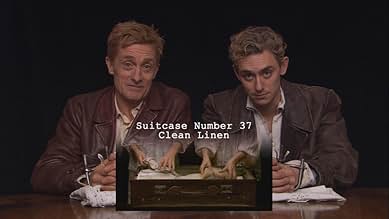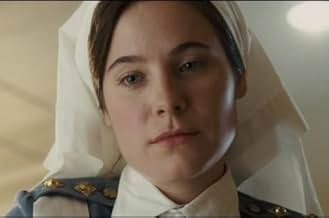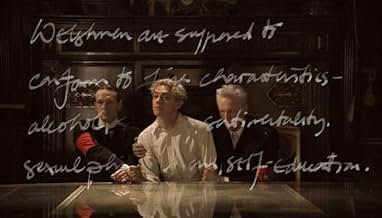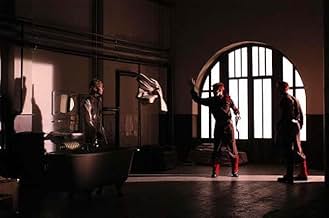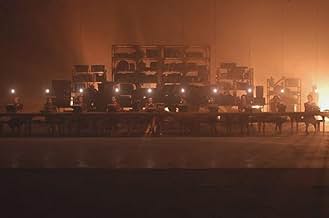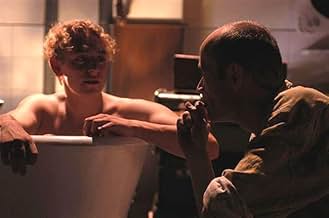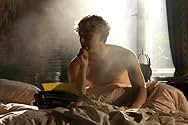As Maletas de Tulse Luper - Parte I: A História de Moab
- 2003
- 2 h 7 min
Adicionar um enredo no seu idiomaThe first of three parts, we follow Tulse Luper in three distinct episodes: as a child during the first World War, as an explorer in Mormon Utah, and as a writer in Belgium during the rise o... Ler tudoThe first of three parts, we follow Tulse Luper in three distinct episodes: as a child during the first World War, as an explorer in Mormon Utah, and as a writer in Belgium during the rise of fascism. Packed with stylistic flourishes, it's a dense, comic study of 20th century his... Ler tudoThe first of three parts, we follow Tulse Luper in three distinct episodes: as a child during the first World War, as an explorer in Mormon Utah, and as a writer in Belgium during the rise of fascism. Packed with stylistic flourishes, it's a dense, comic study of 20th century history, revolving around the contents of one man's suitcases.
- Prêmios
- 1 vitória e 1 indicação no total
- Jan Palmerion
- (as Jordi Molla)
- Pip
- (as Nilo Mur)
Avaliações em destaque
having said all that i still really badly want to see the project as a whole
I won't attempt to describe much of the plot of Greenaway's mad project, such as I saw it, other than to say it traces the life of the title character through the two world wars of the twentieth century. If it is ever completed, one would expect there to be ninety-two "suitcases", hyperlinks as it were, to elements of Tulse Luper's life; one would expect there to be ninety-two common archetypical objects representing human existence; and one would expect there to be ninety-two characters in the movie, many of whom are introduced in split screen "auditions", which Greenaway imagined are analogous to parallel worlds. However, other than the number of times Tulse is physically assaulted, I can't recall any of the numbers going beyond thirty, so clearly there is a long way to go before the film can ever be called completed.
Greenaway described his visual metaphor as capturing elements of toolkits from multimedia computer graphics. The influence of a high bandwidth internet experience is also present. There was something analogous to a magnifier icon for creating a box around an element of a scene to be highlighted. There were panels of foreground videos playing over a background video reminiscent of a Windows Media Player or a Real Player. And there was one scene that split and adjusted the frame of the movie horizontally, like something I'd seen editing a Word document. Of course, all of these elements are subtly redefined to be nonobvious, and graphically balanced and symmetric. In one of the most visually impressive sequences in the film, the camera moves slowly from left to right, and then back, over a row of typists, each of whom has a bare light bulb above her head, and between each of them there is a semi-transparent display of rapidly changing document pages as might be scanned from a database.
Thematically, the film captures the best elements of Greenway. He said he expected Tulse Luper to be his magna opus, and the way he described the infinitely recursive structure of the story, it is likely to be an unfinished symphony. The numbers from Drowning by Numbers are here. The brutality of The Cook the Thief His Wife & Her Lover is, too. The film is expressly referential to Greenaway's earlier works, and he suggests that Tulse Luper is his alter ego.
Greenaway makes much of the architectural elements of the frame -- the Cartesian grid, lots of horizontal and vertical lines, vanishing perspectives, conic shadows of divergent illumination from a point source -- but for me what makes Greenaway Greenaway is brutality for an underlying theme, and lots of artfully naked, sexually expressive people. The visual elements could certainly exist without the rawness, but his films would not be as powerful without it. One scene clearly showed the results of a castration, and many others involved some sort of sexual domination. Greenaway said he is an atheist; I wondered, is he also a practitioner of sexual dominance in his personal life, or is he just doing this to be interesting? Between films, Greenaway sounded almost apologetic in explaining it was about totalitarianism and anti-semitism, but it's problematic for a Britisher in our age of anti-Americanism to present so many fascist characters uttering slurs against the Jews. It's sort of like Shakespeare's Merchant of Venice talking about the Holocaust. Does repeating blood libels, like the Jews supposedly being responsible for communism, somehow perpetuate the injury? Early in the film, a character repeats a mantra to "destroy the evil" as a way presumably to end war, but then later another suggests this sounds like too much of a violent thing to do; one wonders, which is it?
This was certainly the most powerful movie experience I had in 2003, although admittedly I didn't see very many good movies this year. And the scale of Tulse Luper is such that I'm sure it will be one of Greenaway's very best, even if it never achieves a state of completion. It helps vastly of course to see it in the theater and in high definition. While Greenaway regretted the French subtitles, as the version we saw was shown at Cannes, I actually found they added another dimension to the film: not only did they help me catch what the characters were saying when they spoke too fast to hear, but the nuances of French vis-a-via English were enlightening.
The film begins with showing us actors auditioning for roles, which is also used later. Tulse is a young boy with his friend Martino Knockavelli in the back yard of his house in Newport, Wales. A red brick wall collapses on Tulse and then we progress through history, with war footage in the background. Tulse travels to Moab where he is abused and jailed, and then later travels to Antwerp and faces the sinister Red Fox fascists. Throughout the film a small box with the head of a talking expert inside appears (like A TV Dante) describing the background of what is happening. Characters are noted on screen with name and number when they appear. It was fun reading all of Luper's Lost Films that scrolled down the screen, as well as seeing the other suitcases (suitcases 1 - 21 are featured in this film). It was good to see former Greenaway films - Vertical Features Remake, Water Wrackets, A Zed & Two Noughts, and The Belly of an Architect - referenced and appear. Greenaway is really experimenting here with image and sound, using repetitive sound at times giving an echoing effect. He plays with connecting numbers to draw shapes on screen when Percy strikes Tulse. Sometimes the screenplay is shown on screen after the characters have said it. The cinematography by Reinier Van Brummelen is good. The music by Borut Krzisnik is superb and feels appropriate. In the acting stakes Caroline Dhavernas is the stand out, and J.J. Feild does a capable job as Tulse. It's a film that (like all Greenaway films) needs to be watched several times. I look forward to seeing Vaux to the Sea.
Definitely this movie should be seen in the theater, as its just too small for a normal TV-there is so much information on the screen or maybe if you have a projector at home:)
There are probably lots of `mistakes'(like a very hard to follow script, too many characters...etc) in this film, and many people would not understand a thing, but this is just normal, because there is no other movie that can be compare with this one!
IF you love art movies, and you are prepared to give some `food' to your brain, then see this movie, you won't be disappointed.
Probably, Greenaway's idea of creating this multimedia Magnus Opus would be doomed to a commercial failure, but for the real art lovers, I think the movies created for this project would set a landmark.
10 out 10
Você sabia?
- Curiosidades'Cissie Colpitts' is the name shared by the three main female characters in Afogando em Números (1988), by the same director.
- ConexõesEdited into The Tulse Luper Suitcases: Antwerp (2003)
Principais escolhas
- How long is The Tulse Luper Suitcases, Part 1: The Moab Story?Fornecido pela Alexa
Detalhes
- Data de lançamento
- Países de origem
- Central de atendimento oficial
- Idiomas
- Também conhecido como
- The Tulse Luper Suitcases, Part 1: The Moab Story
- Locações de filme
- Empresas de produção
- Consulte mais créditos da empresa na IMDbPro
Bilheteria
- Orçamento
- US$ 10.000.000 (estimativa)
- Faturamento bruto mundial
- US$ 90.071
- Tempo de duração
- 2 h 7 min(127 min)
- Cor
- Mixagem de som
- Proporção
- 1.85 : 1

